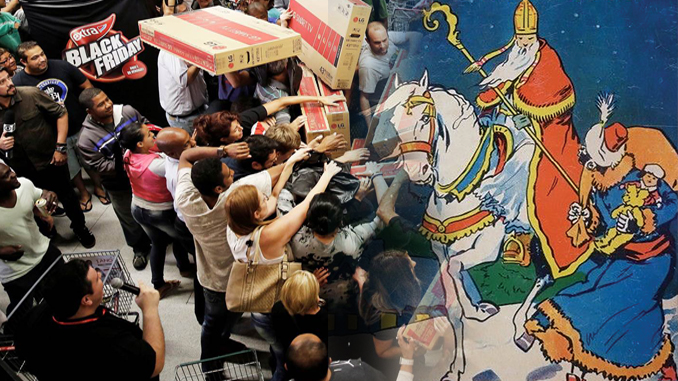
While certain aspects of many Americans’ Christmas celebrations are derived from ancient traditions, some of our customs have evolved fairly recently. Whether your family traditions revolve around solemn candlelight or Santa Claus—or both—we hope each of you have had a very “holly jolly,” peaceful, and joyful Christmas this year!
By S.T. Patrick
The traditional staples of Christmas in America derive their origins from places that are uniquely cultural, religious, traditional, and profitable. From the traditional madness of Black Friday to the dulcet tones of crooner Bing Crosby, Americans either bask in or avidly detest the season that folksinger Burl Ives once called “holly jolly.”
Many of the Christmas traditions that are exhibited today are relatively modern creations based in some history—or historical legend. Parsing their origins between natural, cultural evolution and pure pursuit of profit can often bring out the Grinch in even the most positive person.
The phrase “Black Friday,” for example, dates back to Philadelphia in 1961. Its meaning has evolved from a negative description of increased pedestrian and automobile traffic to one of economic prosperity. It is the time of year when many retail ledgers move from losses (“the red”) to profit (“the black”). Spending in America during the Christmas holiday season now tops $600 billion annually, 73% of which is spent on gifts. The average American spends over $800 on gifts.
While Black Friday is traditionally the day after Thanksgiving, recent years have seen an increase of what is called “Christmas creep.” Many retailers have attempted to extend the seasonal deluge of consumer debt backwards, to Thanksgiving Day or before. Those now irked by Christmas music in October, aggressive seasonal advertising campaigns in November, or QVC’s month-long “Christmas in July” sale of sparkly, overstocked tchotchkes, may believe that “Christmas creep” refers to the corporate vice-president who created the idea of inching the season toward Halloween.
Retail and big business did not let a crisis go to waste, even during the worst economic times. Beginning in the Great Depression, banks began offering Christmas club savings programs that encouraged struggling patrons to save now so that they could spend later. Shortly thereafter, Sears introduced its first Sears Wish Book so that financially strapped citizens would know exactly what to buy.
Santa Claus, the holiday’s most iconic figure, is the subject of some myth and debate, though it is generally agreed today that he has supplanted His birthday celebration. The idea that Coca-Cola created the modern image of Santa Claus solely to sell soft drinks, for instance, is a myth. The imagery of Santa in a red-and-white outfit had existed for decades before Coca-Cola first used the benevolent character to sell products in the 1930s.
One thing that can be said of Santa Claus is that he is typically American. Though generous, who else but an Americanized icon would be known for separating people by his own unilateral definitions of naughty and nice?
The image and legend of Santa Claus is something that has been built over centuries and stems from a historical character, St. Nicholas. Nicholas was a third-century figure born in the then-Greek and now-Turkish village of Patara. When his wealthy parents died early in his life, Nicholas used his inheritance to follow the Christian teachings he had learned. He gave everything he had inherited to aid the sick and the suffering.
Promoted to Bishop of Myra as a young man, he suffered persecution, exile, and imprisonment under the anti-Christian Roman emperor Diocletian. Upon his release, Nicholas attended the Council at Nicaea in A.D. 325. Though his name does not appear on all existing lists of attendees, his presence is corroborated on the oldest existing Greek list, as well as five others. Many of the most accurate legends of Nicholas involve him saving innocents and the unjustly persecuted from prison. When he died on December 6, A.D. 343, legend says that an unusual liquid substance called manna mysteriously formed in his grave. Because manna is said to have healing powers, the legend of Nicholas spread throughout the region and created a following more widespread than any he had experienced in his lifetime.
The responsibility for canonization—the bestowing of sainthood—in the Roman Catholic Church was given to the pope in the late 1100s. Nicholas was given the status of sainthood prior to the East vs. West schism in 1054; therefore, debate exists as to whether St. Nicholas is a saint at all. Although 40 saints were removed during the Roman Catholic calendar revision of 1969, Nicholas was not one of them, so the celebration of his feast day is optional.
Despite commercialism that often borders on the vulgar, America remains the most giving nation in the world. If Christmas still brings a season of giving that would make the ghost of St. Nicholas—and the magi themselves—gloriously gleeful, then just maybe we can all patiently embrace a premature airing of Perry Como’s “Home for the Holidays.” After all, the generosity of the season is still exhibited in our motives and actions if not in our culture.
S.T. Patrick holds degrees in both journalism and social studies education. He spent ten years as an educator and now hosts the “Midnight Writer News” show. His email is [email protected].



” America remains the most giving nation in the world” – you wanna ask the people of Iraq, Syria, Yemen, Libya, Korea, Vietnam, Cambodia and countless other about this
I always learn something from S.T. Patrick’s articles. This is why I love the AFP website.